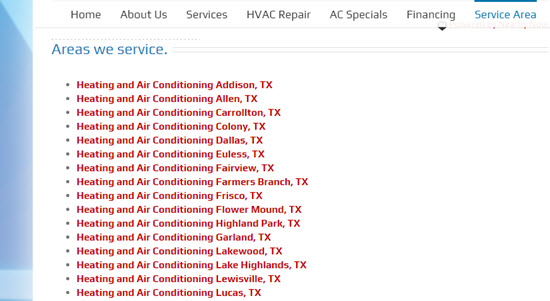
You want to rank for a bunch of keywords in a bunch of cities. You don’t have a physical location in each city – which makes you ineligible for Google My Business pages in all those places – but you figure you can “optimize” as many pages you need. Your competitors do it, so why shouldn’t you? What have you got to lose?
Let’s say own an HVAC company in the Dallas area. You offer 10 main services and want to reach customers in 10 cities. You crank out 10 city pages for “heating repair,” with page names like:
/heating-repair-dallas-tx
/heating-repair-fort-worth-tx
/heating-repair-plano-tx
/heating-repair-arlington-tx
/heating-repair-richardson-tx
/heating-repair-irving-tx
/heating-repair-garland-tx
/heating-repair-mckinney-tx
/heating-repair-denton-tx
/heating-repair-grapevine-tx
Then you need pages on AC repair, so…
/ac-repair-dallas-tx
/ac-repair-fort-worth-tx
/ac-repair-plano-tx
/ac-repair-arlington-tx
/ac-repair-richardson-tx
/ac-repair-irving-tx
/ac-repair-garland-tx
/ac-repair-mckinney-tx
/ac-repair-denton-tx
/ac-repair-grapevine-tx
And so on.
Before you know it, you’ve got 100 pages. (Or maybe you only offer 5 services and in 5 different cities. That’s still 25 pages.)
All the pages are nearly identical, except you swap out the city names and keywords from page to page.

Like the microsite strategy, the cities x services = number of pages strategy is shortsighted and likely to end in one kind of failure or another.
In a minute I’ll tell you what I suggest you do instead. First, here are the problems with your rapidly reproducing pages:
- Even if the 100 “city” pages aren’t too good and you just squirt them out, it’s still a lot of work to build them all.
- What if you make a mistake in your master copy and want to fix it? Whatever it is, do it 100 times.
- It’s hard or impossible to incorporate the pages into your navigation – and not annoy visitors.
- It’s hard or impossible to incorporate the pages into your internal linking – and not annoy visitors.
- Do you at least want the option of writing and building the pages in-house – without spending so much time on them that you drop the ball on everything else?
- Google’s “Doorway Page” update – meant to keep useless “city” pages out of the search results. Now, those pages still pop up too often, so to me Google hasn’t been too serious about running them out of town. But if and when that changes, you don’t want to be the one to find out first.
- What if the pages don’t rank well? Then what? How will you make 100 pages more informative and in-depth? What if you conclude you need to rustle up some good links?
- What if they rank well but don’t get any traffic? What is your plan to make more people click through to those 100 pages from the search results?
- What if they get traffic, but the traffic doesn’t convert? You’ll need to make 100 pages convert better. You wanted those city-service permutation pages because they were quick to pump out. Do you have time to fix 100 failures?
- What if you want to rename the pages or rework the URLs later? Lots of redirects and/or updating your internal links.
- What if some customers see 5 pages that all look the same except for the city? Are they more likely or less likely to call you?
- Do you want to be able to point customers and would-be customer to those pages easily – and verbally, if you want to?
- Do you want competitors, marketers, and customers alike to admire how you market yourself, or conclude that you’re just another hack?
- Your competitors have probably sunk to that strategy already. What makes you think you’ll do the same thing they do but enjoy more success than they’ve had?
- If your competitors haven’t cranked out 100 city pages yet, and they conclude your pages work great for you, how will you stay ahead of them when they follow your lead?
Enough for now about what you shouldn’t do. Here’s what I do suggest:
- Have an in-depth page on each specific service you offer. Have some blurbs on your service area, and link to your pages on each city (see point #2, below), as appropriate.
- Have an in-depth “city” page on each of the main cities you serve. Apply my 25 principles. This spreadsheet may help, too.
The idea is your service pages should have plenty of “city” info, and your city pages should have plenty of info on your services. If you offer 10 services and serve 10 cities, that’s 20 pages. Much more manageable, and it’s at least possible you can make each one good over time.
—
Any drawbacks of the “cities x services = number of pages” strategy that I missed?
Anything to say in its defense?
Any examples of great or hideous city pages?
Leave a comment!